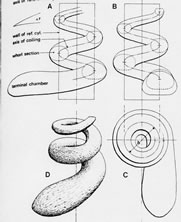

Dimensions of the helical burrow of Diictodon. Unlike the helical burrows of the Miocene beaver, these enlarge in diameter as one goes down towards the terminal chamber. Source: Smith 1987. Used with permission.
|History
Identifying the animal
How characteristic size and shape of a trace is for a particular species has not been studied. Excavations of modern burrows show that a single species can employ a variety of constructions for different uses. Burrows for shelter, hibernation, and brooding can all be different within a single species. In addition, male and female burrows may have different arrangements (Voorhies, 1975).
Size, on the other hand, is often constant, at least for freshly built burrows. Many animals do not begin to dig until they reach a certain age. This, of course, cannot be assumed for extinct animals without modern analogues. There are some other exceptions, for instance, Burns (1996) described smaller tunnels within a fossil prairie dog colony that were likely excavated by juveniles learning to dig.
In addition, burrows excavated by one species may be reshaped by another. Some have suggested that because of collapse of the roof, diametre of a tunnel will grow with the age of the burrow. However, the discovery of Pleistocene open burrows in Argentina suggests that collapse is not an inevitable occurrence even in abandonned and buried burrows (Saffer 2004).